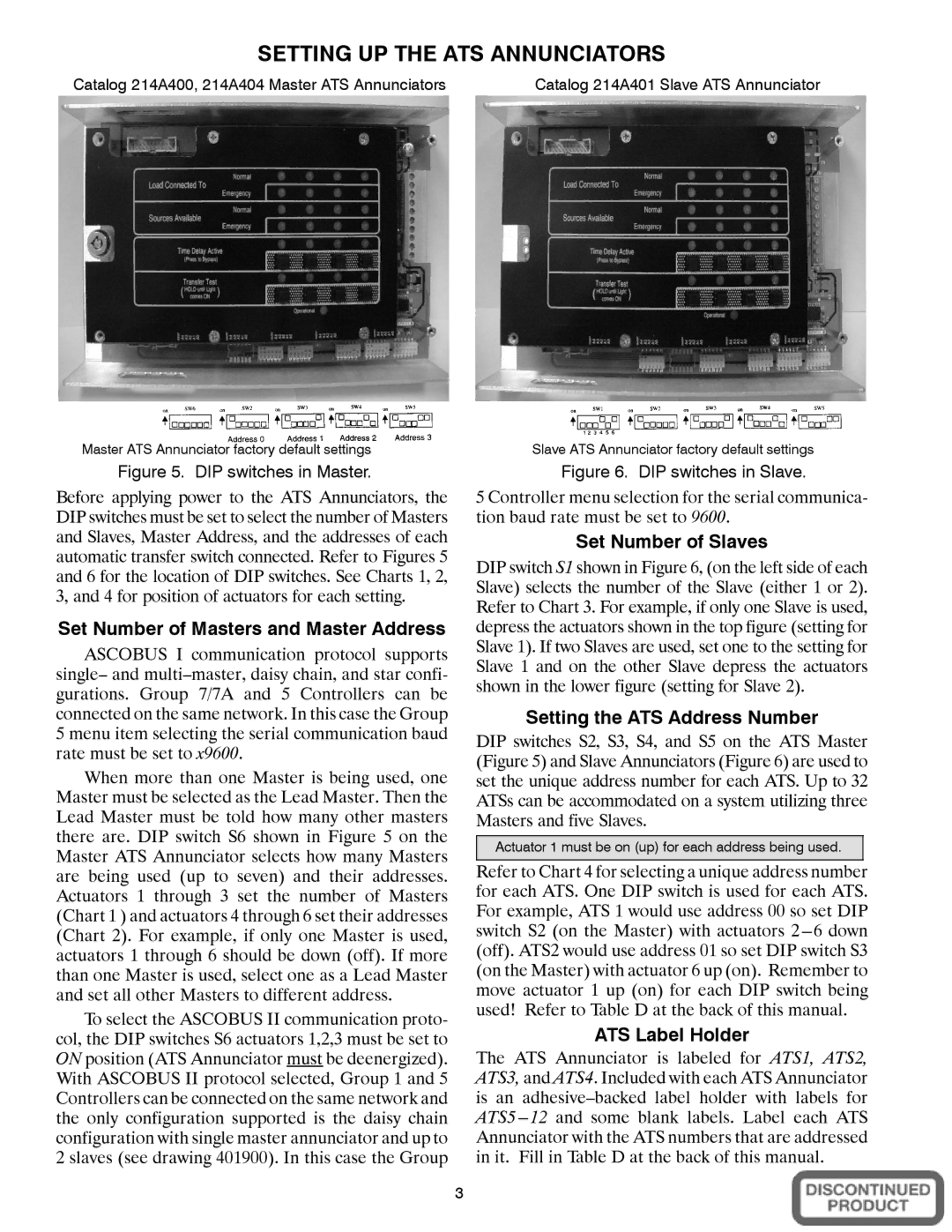
SETTING UP THE ATS ANNUNCIATORS
Catalog 214A400, 214A404 Master ATS Annunciators | Catalog 214A401 Slave ATS Annunciator |
Master ATS Annunciator factory default settings
Figure 5. DIP switches in Master.
Before applying power to the ATS Annunciators, the DIP switches must be set to select the number of Masters and Slaves, Master Address, and the addresses of each automatic transfer switch connected. Refer to Figures 5 and 6 for the location of DIP switches. See Charts 1, 2, 3, and 4 for position of actuators for each setting.
Set Number of Masters and Master Address
ASCOBUS I communication protocol supports single– and
When more than one Master is being used, one Master must be selected as the Lead Master. Then the Lead Master must be told how many other masters there are. DIP switch S6 shown in Figure 5 on the Master ATS Annunciator selects how many Masters are being used (up to seven) and their addresses. Actuators 1 through 3 set the number of Masters (Chart 1 ) and actuators 4 through 6 set their addresses (Chart 2). For example, if only one Master is used, actuators 1 through 6 should be down (off). If more than one Master is used, select one as a Lead Master and set all other Masters to different address.
To select the ASCOBUS II communication proto- col, the DIP switches S6 actuators 1,2,3 must be set to ON position (ATS Annunciator must be deenergized). With ASCOBUS II protocol selected, Group 1 and 5 Controllers can be connected on the same network and the only configuration supported is the daisy chain configuration with single master annunciator and up to 2 slaves (see drawing 401900). In this case the Group
Slave ATS Annunciator factory default settings
Figure 6. DIP switches in Slave.
5 Controller menu selection for the serial communica- tion baud rate must be set to 9600.
Set Number of Slaves
DIP switch S1 shown in Figure 6, (on the left side of each Slave) selects the number of the Slave (either 1 or 2). Refer to Chart 3. For example, if only one Slave is used, depress the actuators shown in the top figure (setting for Slave 1). If two Slaves are used, set one to the setting for Slave 1 and on the other Slave depress the actuators shown in the lower figure (setting for Slave 2).
Setting the ATS Address Number
DIP switches S2, S3, S4, and S5 on the ATS Master (Figure 5) and Slave Annunciators (Figure 6) are used to set the unique address number for each ATS. Up to 32 ATSs can be accommodated on a system utilizing three Masters and five Slaves.
Actuator 1 must be on (up) for each address being used.
Refer to Chart 4 for selecting a unique address number for each ATS. One DIP switch is used for each ATS. For example, ATS 1 would use address 00 so set DIP switch S2 (on the Master) with actuators
ATS Label Holder
The ATS Annunciator is labeled for ATS1, ATS2, ATS3, and ATS4. Included with each ATS Annunciator is an
3
